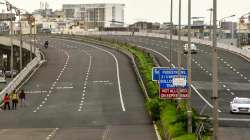In a significant achievement, Maharashtra's longest and widest road tunnel saw the light of day on the upcoming "Hindu Hridaysamrat Balasaheb Thackeray Maharashtra Samruddhi Mahamarg", or the Greenfield project of Mumbai-Nagpur Super Communication Expressway, officials said on Tuesday.
A huge roar of jubilation rent the air after the final blast on the tunnel, marking the culmination of hard labour under the ever-looming threat of the Covid-19 pandemic and lockdown, by a team of engineers and workers of Afcons Infrastructure Ltd, Shapoorji Pallonji Group.
Tunnel over 7 km long
"The tunnel is 7.78-km long, in two tubes with a total width of 35 metres (17.50 metres in each tube) located between Igatpuri (Nashik) and Vashala (Thane), in a thickly forested hilly region," AIL Project Manager and Leader Sekhar Das told IANS.
The road tunnel is part of the 13.10-km long Package 14 handled by AIL for the Maharashtra State Road Development Corporation (MSRDC) and was completed three months ahead of schedule.
Mumbai-Nagpur travel time to be reduced to half from current span
The 701 km-long east-west expressway linking the state capital Mumbai with its second capital Nagpur, is expected to be partially operational by September 2021 and fully completed by May 2022, slashing the travel time between the two cities by half from the existing 16 hours.
The tunnel breakthrough was witnessed by MSRDC Vice-Chairman and Managing Director Radheshyam Mopalwar and other top officers, besides AIL officials on what is stated to be the fastest moving package on the entire expressway.
Besides, there are two small viaducts on the AIL package of 900 metres and 1.20 kms which would enable passage to the wild animals in the forested region where the expressway will not be fenced, said Das.
2 more tunnels on the expressway
The expressway, being built at a total cost of around Rs 55,000 crore, will have two more smaller tunnels - 1.10 kms and 300 metres long besides a vertical shaft and one inclined shaft to provide ventilation to the two tubes.
Das said that the entire tunnel was dug up using the drilling-blasting method at an average speed of over 200 metres for nine months, and achieving the highest speed of 258.40 metres at one point despite huge Covid-19 restrictions and protocols.
Tunnel work continued even during strict Covid protocols
"Several of the workers fell ill despite all precautions, but they were cared for well and returned to work after treatment," Das said.
Expressway to pass through 10 districts
The expressway will pass through 10 districts - Thane, Nashik, Ahmednagar, Jalna, Aurangabad, Buldhana, Washim, Amravati, Wardha and Nagpur, besides giving connectivity at strategic points to another 24 districts of the state's total 36 districts.
Latest India News
